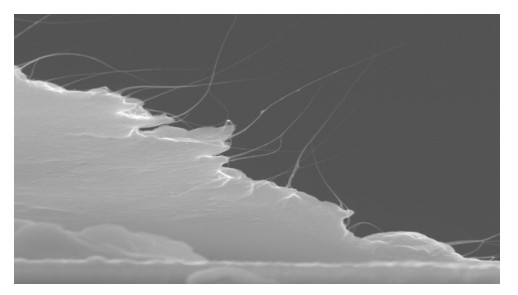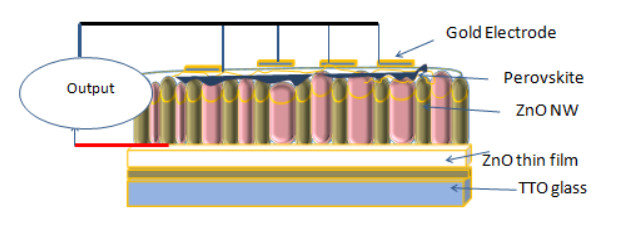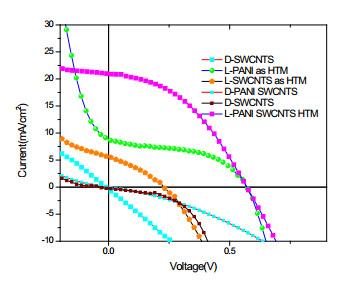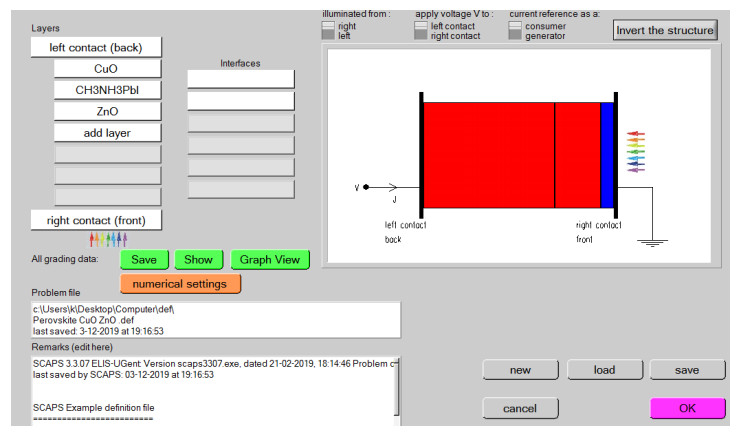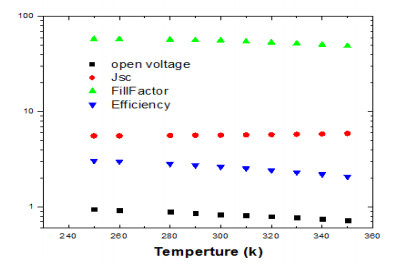Alternate CuO instead of Novel low-cost Polyaniline (PANI)-single wall carbon nanotubes (SWNT or SWCNT) nanocomposite—based hole transport materials (HTMs) as substitutes by thin film of CuO designed as HTM for the applications in Perovskite solar cells. The HTMs were prepared through a facile steps reaction from cheap starting material. These HTMs exhibit good solubility and charge-transport ability but it has big issue regarding temperature due to degrade the conductive polymer, in the same time using ZnO NW as ETM. The perovskite based on PANI-SWNTs achieved power conversion efficiency (PCE) of 5% under air conditions. For perovskite, we found that the solar cells synthesized based on vertical ZnO nanowire arrays by using perovskite organic materials of CH3NH3PbI3 as active absorber materials, Pani-SWNT enable better photovoltaic performance than using CuO as HTM theoretical study by using simulator SCAPS solar cells. These results show that using CuO instead of PANI-SWNTs-HTMs have great prospect to replace the Pani-SWCNTs which is the most widely used HTM to obtain high—stability devices with temperature.
1.
Introduction
The rapid industrial development and population growth all over the world during the past decades have led to an explosion in the global demand for energy. However, the energy supply is still mainly relying on the fossil fuels like oils and coals, which are known to be limited on the earth and are going to dry up in the near future. Therefore, the increasingly severe energy crisis has urged people to find clean and renewable alternatives to fossil fuels. The solar energy, in contrast, is a very clean and sustainable energy source that can offer inexhaustible supply of energy for human society. Thus, the main challenge now is how to harvest the solar energy in a more efficient way. In the existing technologies for solar energy harvesting, photovoltaic (PV), which directly converts solar energy into electric power, is the most promising strategy to deal with the energy crisis we are facing now. Solar cells based on organic-inorganic hybrid perovskite materials, have attracted enormous attention during the past few years. Since the first report of the material used in solar cells in 2009 [1], the power conversion efficiencies (PCEs) of perovskite solar cells (PSCs) have now reached a certified value over 23% [2], showing an unprecedented fast growth rate. PSCs have attained comparable photovoltaic performance to copper indium gallium selenide (CIGS) solar cells (22.9%), and are approaching that of monocrystalline silicon solar cells 26.1% for single-junction silicon cells without concentrators [2]. The hybrid perovskites have been considered to be ideal materials for photovoltaic applications, which are likely attributed to their outstanding optoelectronic properties, ease of processing, and low fabrication costs. Recently, there are more and more reports about the modification of hole transparent material such as nanocomposite conductive polymer/carbon nano tube because it's cheap and easy fabricate of the PSCs like polyaniline/SWCNTS nanocomposite material for block electron to get back to the cathode. The HTM are an essential building block of PSCs architectures. Copper oxide is brown very stable solid semiconductor, and has band gap around 1.2 eV [3]. CuO which is metal oxide represent a p-type semiconductor, and has monoclinic structure with high adsorption coefficient with electrical conductivity between 10 to 105 Ohm.cm the first work reported of solar cells simulation by Lee using 1 dimension program developed by [4], lee and Gray [5]. In this article, we provide experimental and theoretical results recent research work about the applications CuO as HTM instead of nano composite PANI/SWCNTS in PSCs (HTM) are crucial to develop high–throughput this for enhancing the stability and cost effectiveness of PSCs, including experimental, and theoretical study and change the organic HTM which is not stable with in organic semiconductor hole transporting, mechanisms about how the nanocomposite PANI/SWCNTS can contribute to the photovoltaic performances and stabilities of PSCs and compare study with CuO Thin film were discussed.
2.
Numerical modeling and simulation
Many modeling and simulating tools are accessible to day. Solar cells software program in which is solar cells Analysis program in 1 dimension is SCAPS software. A lot of solar cells modules has been used different types of semiconductor materials. For our current work, SCAPS used for the simulation of perovskite solar cells of ZnO/Ch3NH3pbI/CuO perovskite solar cells. The nanostructure of solar cells ZnO/Ch3NH3pbI/CuO hetrojunction solar cells was simulated at different working point temperature and subjected to different environment temperature for heat investigation by using SCAPS.
3.
Solar cells capacitance simulation (SCAPS)
The simulation package of solar cells structures adapted firstly at Gent University using the structure of CdTe and CuInSe2 family [3]. The SCAPS describes the performance of a solar cells mathematically using finite difference methods to solve the differential equations with number of laws and relation in physics of solar cells. SCAPS is numerical solution of the two poison equation and continuity equations on the boundary conditions appropriate to one dimension or two [6]. The express of equations as shown below:
Equation 5 and 6 represent the hole and electron current density.
where Vb and Vn are the effective potentials expressed in Eqs 6 and 7. ΔG is variation in the band structure, μn, μp represent the mobility of electron and hole respectively.
4.
CuO (HTM) absorber (perovskite)/ZnO (ETM)
The absorber layer is made of perovskite materials (CH3NH3pbI). Which has electron affinity of 4.15 and very high hole mobility [7] CuO as HTM, ZnO as electron transport materials (ETM), Al as front contact.
5.
Simulation results
5.1. SCAPS simulation of CuO/Perovskite/ZnO
The parameter data used for the SCAPS simulation were adapted from literature [8,9].
5.2. Experimental details
5.2.1. Growth of ZnO nanowires (NW)
The ZnO NW arrays that vertically aligned have been fabricating on glass substrates (FTO) by electrochemical method at low temperatures. A layer of ZnO thin films were firstly grown on the FTO substrates by using 0.05 M zinc nitrate (Alpha Aessar) that was melted in a blend of methanol and de-ionized water (50v:50v). The time and temperature of the growth were 5min and 70 ℃, respectively. A voltage of −2.5 V was applied with two Au electrodes, that were used as working electrode which connected to the FTO glass substrate and as a counter electrode. ZnO NW arrays were then grown in the next step on the top of the ZnO thin film using an electrolyte, which consists of 0.01 M zinc nitrate and 0.01 M hexamethylenetetramine in de-ionized water. The temperature of this growth was kept at 95 ℃ under a −2.6 V of applied potential between working and counter electrodes as mentioned in our previous manuscripts [3].
5.2.2. Electrochemical polymerization of PANI
In this step, the aniline monomer was used after filtering twice under reduced pressure and melting into a 1 M sulfuric acid to prepare a 0.1 M solution. Then, the polyaniline was fabricated using a galvanostatic step method under a 3 V of applied voltage. FTO glass with a surface area of 1.5 cm2 and a paper clip were used as a working electrode and as a counter electrode, respectively. The estimation of the electro deposited polyaniline amount was done by weighing the working electrode before and after the electro deposition.
5.2.3. Fabrication of PANI-SWNT composite thin-film
In this work, cheap SWNTs were used that have a purity of more than 99 wt%. The dimensions of these tubes are 1–2 nm, 0.8–1.6 nm, and 3–30 µm for the outer diameter, the inner diameter and the length respectively. (0.1 mg) of SWNTs were first melted in 1ml DMF under sonication for 3 h, and then air-brushed onto FTO glass. After that, PANI was precipitated on top of SWNT/FTO glass, and filled the tiny spaces and voids in the network of SWNT. The produced PANI-SWNTs nanocomposite film, that seems to have its two components distributed and mixed uniformly with each other, is shown in the cross section image in Figure 1.
6.
Solar cell fabrication
After preparing FTO glass/ZnO NW structure, perovskite solution was immersed on it and let to dry. Then, the surfaces of both FTO/PANI-SWNT and FTO/ZnO NW/perovskite structures were exposed with a mixture of [CH3NH3PbI3]. The final solar cells' structure was carried out by sandwiching the FTO glass/ZnO NW/ perovskite and PANI-SWNT/FTO glasses as it can be seen in Figure 2.
7.
Result and discussion
PANI returns to the conductive polymers' group with non-degenerate ground state, which significantly affects its electrical and optical properties [11]. The essential charge carriers in these polymers are polarons, and after effective amount of doping, bipolarons instead of solitons [12]. Typical Band gap value of pristine PANI is about 400 nm, and it depends mainly on conditions of fabrication [13]. In addition, PANI exhibits high absorption of sub-band gap, that can be understood because of the transitions between valence band, polaron, and bipolaron states PANI offers only very low photoluminescence (PL) quantum yield although its strong broad-band absorption in comparison with other polymers with non-degenerate ground state [14].
From Figure 3, it can be seen that there is a significant improvement in the performance of the PSCs when using PANI-SWNTs as HTM. The cell with SWNTs produces higher values in all solar cell parameters overall. It has higher output current then the one with pristine PANI. Also, its short-circuit current density JSC is enhanced from 4.5 to 11 mA/cm2, and its open-circuit voltage VOC is increased from 0.38 to 0.56 mV. Moreover, the fill factor FF is improved from 20% to 30%, and the conversion efficiency is enhanced from 1.55 to 5% by using SWNTs. These results demonstrate that using SWNTS plays an important role in solar cell performance, and would increase its conversion efficiency to two times. This improvement can be understood from the impact of the increment of contact area between the PANI-SWNT (HTM) and the ZnO (ETM), which provides efficient charge transportation in PCSs.
Effect of changing in environment temperature on the perovskite solar cells, sun light inter the window of solar cells through the substrate and CuO in to the absorber materials which is perovskite in a typical (p-i-n) hetrojunction. The temperature increase in the summer session, and degrease in the winter in this study the perovskite is used as the absorber layer, CuO as a hole transport materials, and ZnO as Electron Transport materials. In addition to study on effect of increase or degrease the temperature on the efficiency, I-V characteristic, and Full factor. The spectrum used for the structure of solar cells from 200 nm–1000 nm. A schematic representation of the structure solar cells which simulated by SCAPs is shown in Figure 4.
The efficiency is calculated from Eq 8
The results of simulation I-V characteristic such as PCE, FF, Jsc, and Voc of the perovskite solar cells with varying environment temperature as shown in the Table 2 where the highest efficiency is 3.05% with Jsc = 5.57 mA/cm2, FF = 57.85% and Voc = 0.947 is achieved when the temperature at 250 K, therefore the best result at very low temperature to be very appropriate to work in space. When the temperature is increasing from 250 K to 350 K, the PCE, and Jsc degrees due to reduce in generation of the electron-hole pairs in the perovskite materials with increase temperature as shown in the Figure 5.
From the Figure 5 the open circuit voltage digresses gradually with increase temperature, it can adjust the efficiency with temperature due to control of the recombination, generation, and a collection of the charge carriers so the best temperature of perovskit solar cells with CuO as HTM is 250 k.
In the same time, it can be seen that the device of perovskite solar cells of (CuO/CH3NH3PbI) has very high stability with temperature as shown in the Figure 5 the changing is small in parameter, which can conclude that the stability base temperature is very stabile and resistant to temperature.
The perovskite solar cells stability shown in Figure 6. As we can see from the figure that the practical relevance efficiency remains stabile with time for CuO thin film, comparing with PANI/Swcnts its short device operation time at 20 hour the efficiency was 5% then after 500 hour become 2.9% the percentage of reduction is 42%. While the CuO thin film degrees from 2.64% at 20 hour to 2.07% the percentage reduction is approximately 21% which means two times more satiability than the device with PANI/Swcnts, so the device performance is not degraded during aging for the device with CuO thin film that's mean the device with Pani/Swcnts despite of it has higher efficiency but has short device operation time as HTM.
8.
Conclusions
In short, we have fabricated and simulated the perovskite solar cells using two type of HTM. The Organic HTM which is polyaniline-single wall carbon nanotube (PANI-SWNT) composites, and in organic CuO thin film. The in organic HTM of CuO which theoretical study with different environment temperature used in perovskite solar cells (PSCs). ZnO nanowire arrays were deposited vertically on ZnO buffered FTO glass and applied as a 3D photo anode. High efficiency PSCs were designed by sandwiching the FTO glass/ZnO NW/perovskite and PANI-SWNT (HTM)/FTO glasses. Our study stated that 5% power conversion efficiency of PSCs was obtained from the device with PANI-SWNT composite as HTM considerably higher than that built with in organic CuO HTM where reached 3% by adapted SCAPS software. Also the study with variety of temperature with best efficiency 3.05% at 250 K to be amazing device work at low temperature specially in space, in the same time it has high stability with variety of environment of temperature. light conversion enhancement is due to effective improvements in hole transport in the PANI-SWNT composites, and enhanced photon absorption due to the ZnO array's vertical structure. In addition, study the stability issue for long term of perovskite solar cells with both HTM where CuO more stable than the device with Pani/Swcnts nanostructure as HTM.
Acknowledgments
we would like to thank mark burgelman, the electronic and information system (elis), university of gent, belgium, for providing us the free access of scaps simulation software.
Conflict of interest
The authors whose names are listed immediately below certify that they have NO affiliations with or involvement in any organization or entity with any financial interest or non-financial interest.









 DownLoad:
DownLoad:
